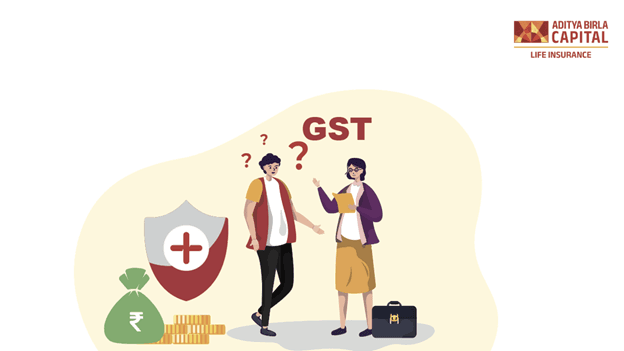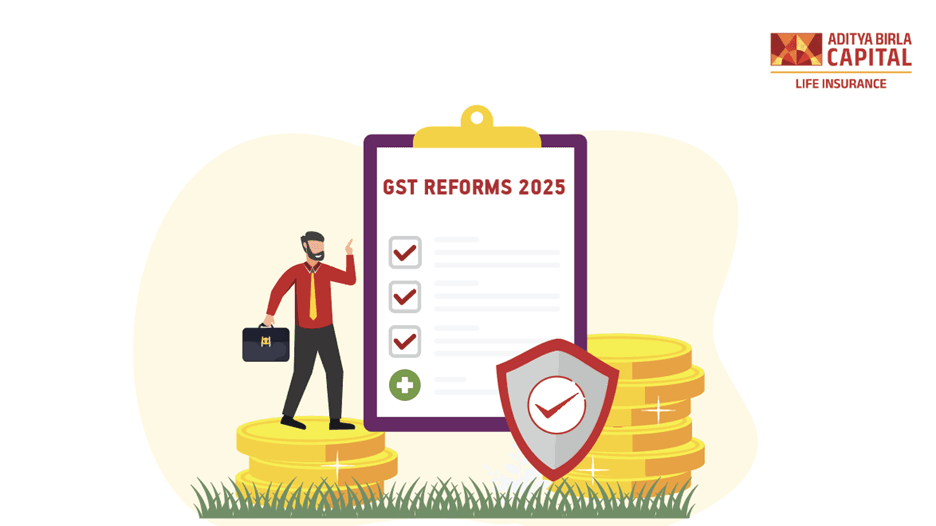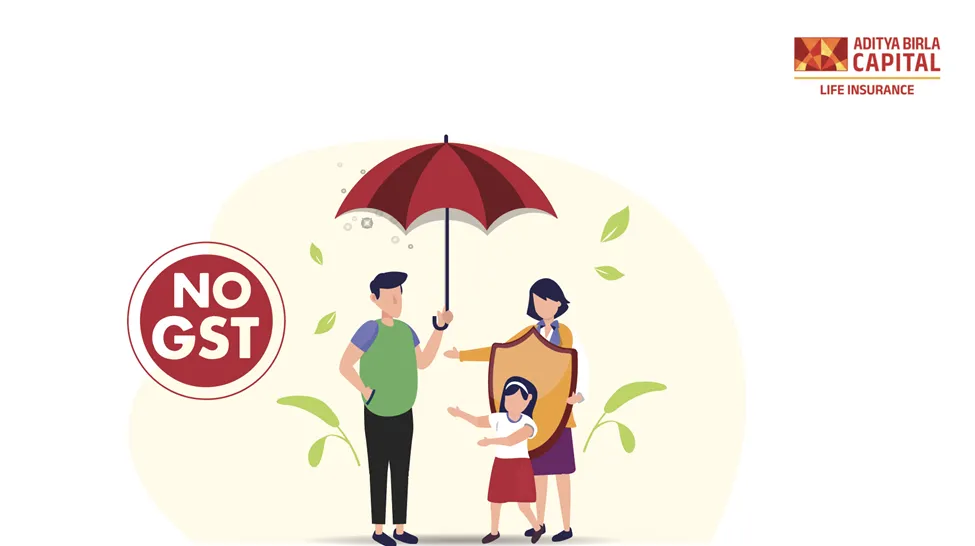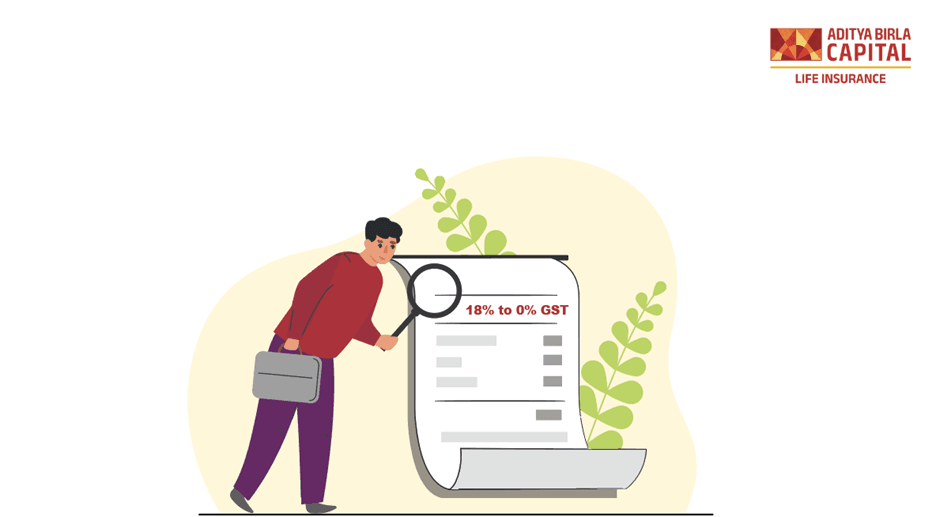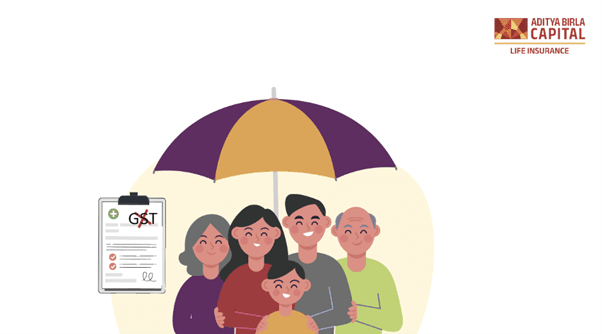When the Goods and Services Tax (GST) was first introduced in 2017, life insurance policies were placed under the 18% tax bracket. For years, this additional cost became part of every policyholder’s premium, something most of us quietly accepted as a small price to pay for financial protection.
But that changed dramatically on 22 September 2025, when the GST Council announced a sweeping reform, life insurance is now exempt from GST. This single decision has reshaped how millions of Indians view life insurance, making it more affordable, accessible, and impactful than ever before.
In this article, we’ll break down what exactly changed after 22 September, what it means for your existing and new policies, and how this reform affects your long-term financial planning.
A Quick Look Back: What Was the GST on Life Insurance Before the Change?
Until recently, life insurance policies were subject to 18% GST. This tax applied across most plan types, though in slightly different ways depending on the policy structure.
Here’s a quick breakdown:
- Term Insurance Plans: Full GST of 18% applied to the entire premium amount.
- Endowment or Savings Plans: GST applied only to the risk portion of the premium.
- ULIPs (Unit Linked Insurance Plans): GST charged on the premium and fund management charges.
- Riders and Add-ons: Add-on benefits such as critical illness or accidental death covers also attracted GST.
So, if you were paying ₹25,000 for your life insurance policy, ₹3,800 of that went toward GST, an amount that didn’t contribute to your life cover or savings value.
After 22 September 2025, this has completely changed. GST on life insurance premiums has been reduced from 18% to 0%.
Why Did the Government Announce This Change?
The decision to remove GST from life and health insurance wasn’t an isolated move, it came as part of the broader 56th GST Council Meeting held in September 2025.
The Council reviewed multiple sectors where taxation was acting as a barrier to essential services. Insurance was one of them.
Here’s why this reform made sense:
1. To Make Insurance More Affordable
The government recognised that insurance is not a luxury, it’s a necessity. With rising living costs and inflation, even a small tax reduction can make a big difference in how families manage their protection and savings plans.
2. To Increase Insurance Penetration
India’s life insurance penetration (as a percentage of GDP) stands at just around 3.7%1. In comparison, developed nations range between 7%1. Removing GST encourages more people, especially middle-income households, to buy policies.
3. To Support Financial Inclusion
This move supports the larger goal of ‘Insurance for All by 2047’, ensuring that every Indian household has access to basic financial protection.
4. To Encourage Long-Term Savings
Life insurance is one of the most trusted ways to build disciplined long-term savings. By removing GST, the government is encouraging families to think beyond short-term expenses and start planning for future milestones.
What Exactly Changed After 22 September 2025
Let’s look at the key changes that came into effect:
| Aspect | Before (till 21 September 2025) | After (from 22 September 2025) |
|---|
| GST Rate on Life Insurance | 18% | 0% |
| Premium Amount | Included GST in final price | No GST added to premium |
| Applicability | Life, health, and riders | Exempt for all insurance types |
| Policy Renewals | Taxed at 18% till expiry | Renewals post 22 Sept are GST-free |
| Impact on Affordability | Premiums were higher | Premiums reduced by up to 18% |
In simple terms, every new policy purchased or renewed after 22 September 2025 is now completely GST-free.
How This Impacts Your Premiums
The immediate and most visible impact is lower premiums.
Here’s an example to put it into perspective:
| Particulars | Before 22 Sept 2025 (18% GST) | After 22 Sept 2025 (0% GST) |
|---|
| Base Premium | ₹10,000 | ₹10,000 |
| GST | ₹1,800 (18%) | ₹0 |
| Total Premium Payable | ₹11,800 | ₹10,000 |
| Overall Savings | - | ₹1,800 saved on every payment |
(Illustrative figures for understanding only.)
These savings might seem small at first glance, but they add up significantly over time. A 25-year policy can now save thousands of rupees that would otherwise go toward taxes.
Impact on Different Life Insurance Products
1. Term Insurance
The most direct beneficiary of this reform is term insurance, pure protection plans where every rupee of your premium goes toward securing your family’s future.
Since term plans previously carried full 18% GST, their cost has now reduced substantially. This makes it easier for more people, especially young earners, to buy higher cover amounts early in life.
2. Savings and Endowment Plans
Savings plans combine protection with guaranteed# returns. Earlier, the GST applied to a part of the premium. Now, the entire contribution goes toward your life cover and guaranteed# benefit, increasing your effective return over time.
3. ULIPs (Unit Linked Insurance Plans)
ULIPs were affected both by GST on premiums and fund management charges. The exemption ensures that more of your money is invested directly into your fund, helping you grow wealth faster over the policy term.
4. Whole Life and Retirement Plans
For policies that span decades or even a lifetime, the removal of GST brings significant savings in the long run. It’s particularly beneficial for those using insurance for legacy planning or retirement income generation.
How It Affects Existing Policyholders
If you already have a life insurance policy, here’s what the reform means for you:
1. Lower Renewal Premiums
The new 0% GST rate will apply automatically to renewals made after 22 September 2025. You’ll notice a reduced payable premium amount from your next payment cycle.
2. No Changes in Coverage or Benefits
Your policy coverage, benefits, and terms remain the same. Only the tax component is removed, ensuring your policy becomes lighter on the wallet without affecting your protection.
3. Better Returns for Long-Term Plans
For policies that combine protection and investment, the removal of GST ensures that your total maturity value or fund accumulation improves slightly over time, since a greater portion of your premium is now invested.
4. Riders Become More Affordable
If you had been avoiding add-ons like critical illness or waiver of premium riders due to extra cost, now is a good time to revisit them. All riders are also GST-free post this reform.
How It Helps New Buyers
If you’re planning to buy life insurance now, the reform offers several key advantages:
- Lower Entry Cost: You can now start a plan at a lower cost, as the premium no longer includes GST.
- Transparent Pricing: The cost structure is simpler, without hidden tax components.
- Higher Coverage: You can buy higher coverage amounts for the same budget.
- Greater Flexibility: More affordable premiums allow you to combine term protection with savings or riders for holistic coverage.
Why This Move Benefits the Middle-Class the Most
Middle-income families are often the most financially stretched, balancing household expenses, EMIs, education fees, and savings. For them, the 18% GST often acted as a psychological barrier to purchasing insurance.
With this exemption:
- Premiums feel lighter.
- More people can afford multiple covers.
- Family protection doesn’t require cutting down on other goals.
This directly supports India’s growing middle class, ensuring that financial protection becomes a practical part of every household budget.
Financial and Emotional Benefits Combined
While this reform clearly saves money, it also delivers something equally important, peace of mind.
Knowing that your family’s future is secure, without feeling overburdened by taxes, changes how people view life insurance. It shifts the narrative from “an extra expense” to “a meaningful investment.”
- Families can plan confidently for the future.
- Individuals can protect dependents without straining their finances.
- Policyholders can renew without hesitation.
When protection becomes affordable, peace of mind becomes universal.
How the Insurance Industry Benefits
The GST exemption doesn’t just help customers, it strengthens the entire insurance ecosystem.
- Higher Policy Adoption: Lower premiums encourage first-time buyers.
- Increased Renewals: More affordable renewals mean fewer lapsed policies.
- Wider Market Reach: Insurers can target untapped segments in rural and semi-urban India.
- Simplified Pricing: Easier to explain and promote policies without tax complexity.
- Boost to Long-Term Capital: Increased insurance participation means more funds channelled into national investment and development.
How This Reform Aligns with India’s Long-Term Goals
The GST exemption directly supports key national priorities:
- Insurance for All by 2047: Ensuring every Indian family is protected.
- Financial Inclusion: Making financial security accessible to all income groups.
- Ease of Doing Business: Simplifying taxation for insurers and intermediaries.
- Economic Stability: Encouraging savings and reducing out-of-pocket financial distress.
It’s not just a policy tweak, it’s a step toward a financially stronger India.
How to Make the Most of This Change
Whether you already have a policy or are planning to buy one, here’s how you can use this opportunity wisely:
- Review Your Existing Policies: Check your insurer’s revised premium structure and note the savings.
- Increase Coverage: Use the saved amount to enhance your sum assured.
- Add Riders: Protect yourself against critical illness or disability with affordable add-ons.
- Start a New Plan: If you’ve delayed buying life insurance, this is the ideal time to start.
- Plan Long-Term: Choose policies that help you save or invest for future milestones, like your child’s education or retirement.
Small steps today can create lasting financial security for your family.
A Closer Look at Premium Savings
Let’s understand how much you can save in real terms.
| Particulars | Before 22 Sept 2025 (18% GST) | After 22 Sept 2025 (0% GST) | Savings |
|---|
| Base Premium | ₹20,000 | ₹20,000 | - |
| GST Amount | ₹3,600 | ₹0 | ₹3,600 |
| Total Premium Payable | ₹23,600 | ₹20,000 | ₹3,600 every year |
| Potential Savings Over 25 Years | - | - | ₹90,000 (approx.) |
(Illustrative figures for understanding only.)
That’s money that stays in your pocket every single year, and when invested or saved, can multiply into meaningful wealth over time.
Practical Scenarios
Scenario 1: A Young Professional Starting Out
Riya, 27, buys her first term insurance policy for ₹1 crore. Earlier, her premium of ₹10,000 became ₹11,800 with GST. After 22 September, she pays only ₹10,000, and uses the ₹1,800 saved to start a small SIP.
Scenario 2: A Family Man with Multiple Policies
Amit, 40, has both term and savings plans. His total annual premium bill reduces by nearly ₹8,000 post-reform, enough to pay for his family’s annual health check-ups.
Scenario 3: A Retiree with a Long-Term Policy
Mr. Sharma, 60, continues paying for a savings-cum-insurance plan. The exemption helps him save around ₹5,000 annually, providing much-needed relief in retirement.
These everyday examples show how impactful the change truly is, across age groups and income levels.
What It Means for India’s Future
Over the next few years, this reform is expected to:
- Encourage more than 1 crore new life insurance buyers annually.
- Boost renewal rates by reducing policy lapse due to high cost.
- Strengthen public awareness around financial protection.
When protection becomes affordable, savings rise, and financial stability follows. This reform, therefore, is not just about taxation, it’s about building a secure financial culture.
Final Thoughts
Life insurance has always been one of the most powerful tools for financial protection, but affordability often stood in the way.
The decision to remove GST on life insurance after 22 September 2025 has changed that for good. Now, every rupee you invest goes directly toward securing your family’s future, not toward taxes.
If you’ve been waiting for the right time to start or expand your insurance portfolio, this is it.
Because a stronger, safer, and more protected tomorrow begins with the decisions you make today.

